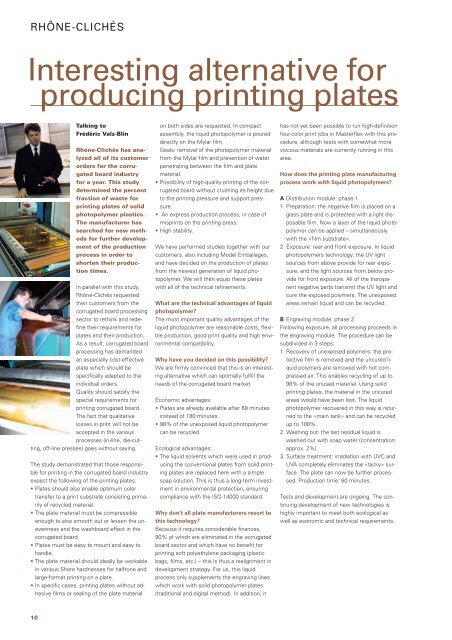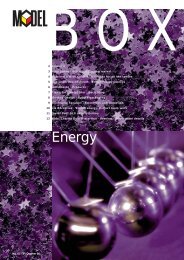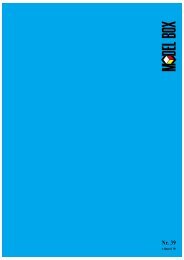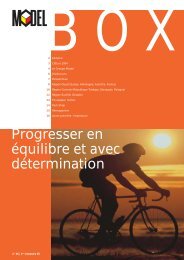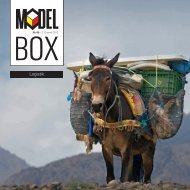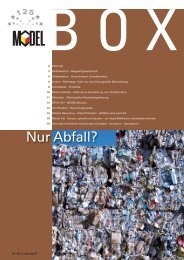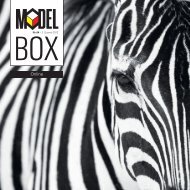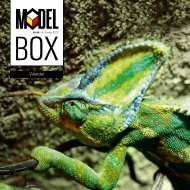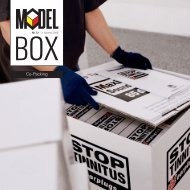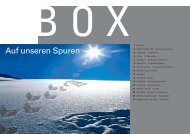Only waste? - Model Holding AG
Only waste? - Model Holding AG
Only waste? - Model Holding AG
- TAGS
- www.modelgroup.com
You also want an ePaper? Increase the reach of your titles
YUMPU automatically turns print PDFs into web optimized ePapers that Google loves.
RHÔNE-CLICHÉS<br />
Interesting alternative for<br />
producing printing plates<br />
10<br />
Talking to<br />
Frédéric Valz-Blin<br />
Rhône-Clichés has analyzed<br />
all of its customer<br />
orders for the corrugated<br />
board industry<br />
for a year. This study<br />
determined the percent<br />
fraction of <strong>waste</strong> for<br />
printing plates of solid<br />
photopolymer plastics.<br />
The manufacturer has<br />
searched for new methods<br />
for further development<br />
of the production<br />
process in order to<br />
shorten their production<br />
times.<br />
In parallel with this study,<br />
Rhône-Clichés requested<br />
their customers from the<br />
corrugated board processing<br />
sector to rethink and redefine<br />
their requirements for<br />
plates and their production.<br />
As a result, corrugated board<br />
processing has demanded<br />
an especially cost-effective<br />
plate which should be<br />
specifically adapted to the<br />
individual orders.<br />
Quality should satisfy the<br />
special requirements for<br />
printing corrugated board.<br />
The fact that qualitative<br />
losses in print will not be<br />
accepted in the various<br />
processes (in-line, die-cutting,<br />
off-line presses) goes without saying.<br />
The study demonstrated that those responsible<br />
for printing in the corrugated board industry<br />
expect the following of the printing plates:<br />
Plates should also enable optimum color<br />
transfer to a print substrate consisting primarily<br />
of recycled material.<br />
The plate material must be compressible<br />
enough to also smooth out or lessen the unevenness<br />
and the washboard effect in the<br />
corrugated board.<br />
Plates must be easy to mount and easy to<br />
handle.<br />
The plate material should ideally be workable<br />
in various Shore hardnesses for halftone and<br />
large-format printing on a plate.<br />
In specific cases, printing plates without adhesive<br />
films or sealing of the plate material<br />
on both sides are requested. In compact<br />
assembly, the liquid photopolymer is poured<br />
directly on the Mylar film.<br />
Goals: removal of the photopolymer material<br />
from the Mylar film and prevention of water<br />
penetrating between the film and plate<br />
material.<br />
Possibility of high-quality printing of the corrugated<br />
board without crushing its height due<br />
to the printing pressure and support pressure.<br />
An express production process, in case of<br />
misprints on the printing press.<br />
High stability.<br />
We have performed studies together with our<br />
customers, also including <strong>Model</strong> Emballages,<br />
and have decided on the production of plates<br />
from the newest generation of liquid photopolymer.<br />
We will then equip these plates<br />
with all of the technical refinements.<br />
What are the technical advantages of liquid<br />
photopolymer?<br />
The most important quality advantages of the<br />
liquid photopolymer are reasonable costs, flexible<br />
production, good print quality and high environmental<br />
compatibility.<br />
Why have you decided on this possibility?<br />
We are firmly convinced that this is an interesting<br />
alternative which can optimally fulfill the<br />
needs of the corrugated board market.<br />
Economic advantages:<br />
Plates are already available after 60 minutes<br />
instead of 180 minutes.<br />
98% of the unexposed liquid photopolymer<br />
can be recycled.<br />
Ecological advantages:<br />
The liquid solvents which were used in prod -<br />
ucing the conventional plates from solid printing<br />
plates are replaced here with a simple<br />
soap solution. This is thus a long-term investment<br />
in environmental protection, ensuring<br />
compliance with the ISO-14000 standard.<br />
Why don't all plate manufacturers resort to<br />
this technology?<br />
Because it requires considerable finances,<br />
90% of which are eliminated in the corrugated<br />
board sector and which have no benefit for<br />
printing soft polyethylene packaging (plastic<br />
bags, films, etc.) – this is thus a realignment in<br />
development strategy. For us, this liquid<br />
process only supplements the engraving lines<br />
which work with solid photopolymer plates<br />
(traditional and digital method). In addition, it<br />
has not yet been possible to run high-definition<br />
four-color print jobs in Masterflex with this procedure,<br />
although tests with somewhat more<br />
viscous materials are currently running in this<br />
area.<br />
How does the printing plate manufacturing<br />
process work with liquid photopolymers?<br />
A Distribution module: phase 1<br />
1. Preparation: the negative film is placed on a<br />
glass plate and is protected with a light dis -<br />
posable film. Now a layer of the liquid photopolymer<br />
can be applied – simultaneously<br />
with the «film substrate».<br />
2. Exposure: rear and front exposure. In liquid<br />
photopolymers technology, the UV light<br />
sources from above provide for rear exposure,<br />
and the light sources from below provide<br />
for front exposure. All of the transparent<br />
negative parts transmit the UV light and<br />
cure the exposed polymers. The unexposed<br />
areas remain liquid and can be recycled.<br />
B Engraving module: phase 2<br />
Following exposure, all processing proceeds in<br />
the engraving module. The procedure can be<br />
subdivided in 3 steps:<br />
1. Recovery of unexposed polymers: the protective<br />
film is removed and the uncured liquid<br />
polymers are removed with hot compressed<br />
air. This enables recycling of up to<br />
98% of the unused material. Using solid<br />
printing plates, the material in the uncured<br />
areas would have been lost. The liquid<br />
photopolymer recovered in this way is returned<br />
to the «main tank» and can be recycled<br />
up to 100%.<br />
2. Washing out: the last residual liquid is<br />
washed out with soap water (concentration:<br />
approx. 2%).<br />
3. Surface treatment: irradiation with UVC and<br />
UVA completely eliminates the «tacky» surface.<br />
The plate can now be further processed.<br />
Production time: 60 minutes.<br />
Tests and development are ongoing. The continuing<br />
development of new technologies is<br />
highly important to meet both ecological as<br />
well as economic and technical requirements.


